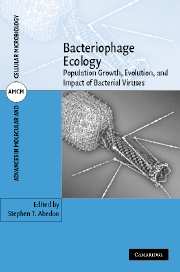Book contents
- Frontmatter
- Contents
- About the cover
- List of contributors
- Foreword by Bruce R. Levin
- Preface
- 1 Phages, ecology, evolution
- Part I Phage ecology
- Part II Phage evolutionary biology
- Part III Phage ecology in environments
- Part IV Modeling phage ecology
- 15 Modeling bacteriophage population growth
- 16 Modeling phage plaque growth
- 17 Modeling of bacteriophage therapy
- Index
- Plate section
15 - Modeling bacteriophage population growth
from Part IV - Modeling phage ecology
Published online by Cambridge University Press: 29 September 2009
- Frontmatter
- Contents
- About the cover
- List of contributors
- Foreword by Bruce R. Levin
- Preface
- 1 Phages, ecology, evolution
- Part I Phage ecology
- Part II Phage evolutionary biology
- Part III Phage ecology in environments
- Part IV Modeling phage ecology
- 15 Modeling bacteriophage population growth
- 16 Modeling phage plaque growth
- 17 Modeling of bacteriophage therapy
- Index
- Plate section
Summary
INTRODUCTION
Different people have different views of what modeling biological phenomena is all about. For some, models are mathematical equations, also known as formal models (Haefner, 1996), that represent, for example, the growth of populations. For others, complex systems are studied in a simplified form in the laboratory, using experiments as physical models (Haefner, 1996). In other words, models, as broadly defined, are simplified representations of reality. This simplifying of the real world, though crucial to modeling success, nevertheless is a dangerous practice. Simplify too far, and a model's solutions, whether mathematical or empirical, will have nothing to do with reality. Simplify too little, and the model becomes too difficult to solve or too complex to derive useful conclusions from. A typical and ecologically very legitimate simplification, for example, is to ignore molecular or physiological details to concentrate instead on properties of whole organisms such as their fecundity or age of death. In this tradition, here we consider phage—bacterial, predator—prey interactions in fluid environments.
The environment of phages and bacteria may be modeled as unchanging over time, changing due to phage or bacterial actions (e.g., bacterial depletion due to phage growth or substrate consumption due to bacterial growth), or changing as a consequence of factors external to both phages and bacteria (e.g., due to chemostat outflow or protist grazing).
- Type
- Chapter
- Information
- Bacteriophage EcologyPopulation Growth, Evolution, and Impact of Bacterial Viruses, pp. 389 - 414Publisher: Cambridge University PressPrint publication year: 2008
- 8
- Cited by



